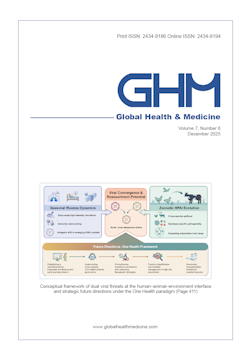Global Health & Medicine 2023;5(4):216-222.
Steady-state pharmacokinetics of plasma tenofovir alafenamide (TAF), tenofovir (TFV) and emtricitabine (FTC), and intracellular TFVdiphosphate and FTC-triphosphate in HIV-1 infected old Japanese patients treated with bictegravir/FTC/TAF
Tran TH, Tsuchiya K, Kawashima A, Watanabe K, Hayashi Y, Ryu S, Hamada A, Gatanaga H, Oka S
Emtricitabine (FTC) plus tenofovir alafenamide (TAF) has demonstrated efficacy and safety for pre-exposure prophylaxis (PrEP) to prevent HIV-1 infection. We measured the plasma PK of FTC, tenofovir (TFV), and TAF in a steady-state pharmacokinetic (PK) study of bictegravir/FTC/TAF in HIV-1-infected patients. Furthermore, validated liquid chromatography-tandem mass spectrometry was used to measure intracellular TFV-diphosphate (DP) and FTC-triphosphate (TP), the active metabolites of TFV and FTC, respectively. Plasma and dried blood spot samples were collected from 10 male patients aged ≥ 50 years at various time intervals: 0 (trough), 1, 2, 3, 4, 6, 8, 12, and 24 h after drug administration. The mean ± standard deviation of plasma PK parameters were as follows: The maximum concentrations of TAF, TFV, and FTC were 104.0 ± 72.5, 27.9 ± 5.2, and 3,976.0 ± 683.6 ng/mL, respectively. Additionally, their terminal elimination half-lives were 0.6 ± 0.5, 31.6 ± 10.4, and 6.9 ± 1.4 h, respectively. These results were consistent with previously reported data. The intracellular levels of TFV-DP and FTC-TP varied widely among individuals; however, they remained stable over 24 h in each individual at approximately 1,000–1,500 and 2,000–3,000 fmol/punch, respectively, indicating that plasma concentrations did not affect the intracellular concentrations of their active metabolites. These results demonstrated that measuring intracellular TFV-DP and FTC-TP could be useful for monitoring adherence to PrEP in clients on this regimen.
DOI: 10.35772/ghm.2023.01060







